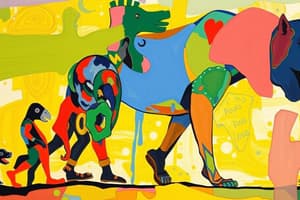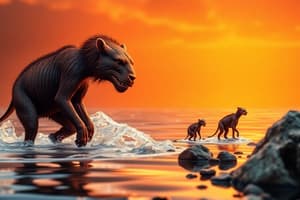Podcast
Questions and Answers
What is a primary characteristic of genetic drift?
What is a primary characteristic of genetic drift?
- It is a random change in allele frequency. (correct)
- It consistently leads to adaptations in populations.
- It occurs only in large populations.
- It involves the intentional selection of traits by humans.
Which situation correctly describes gene flow?
Which situation correctly describes gene flow?
- A natural disaster reduces a population size drastically.
- A small group migrates and starts a new population.
- New mutations arise in a population leading to variation.
- Pollen is transferred between different plant populations. (correct)
Which of the following is NOT one of the conditions required for Hardy-Weinberg equilibrium?
Which of the following is NOT one of the conditions required for Hardy-Weinberg equilibrium?
- Random mating must occur.
- No natural selection can take place.
- There should be a moderate population size. (correct)
- There must be no mutations present.
Which of the following modes of natural selection is explained by mate preference?
Which of the following modes of natural selection is explained by mate preference?
Microevolution occurs when which of the following Hardy-Weinberg equilibrium conditions are violated?
Microevolution occurs when which of the following Hardy-Weinberg equilibrium conditions are violated?
What process results in individuals with certain traits having higher survival and reproduction rates?
What process results in individuals with certain traits having higher survival and reproduction rates?
Which principle explains why more offspring are produced than can survive?
Which principle explains why more offspring are produced than can survive?
In Darwin's theory, what is the significance of traits being heritable?
In Darwin's theory, what is the significance of traits being heritable?
What drives genetic variation in populations?
What drives genetic variation in populations?
How does artificial selection differ from natural selection?
How does artificial selection differ from natural selection?
What is a gene pool?
What is a gene pool?
Which of the following is NOT considered a selective pressure?
Which of the following is NOT considered a selective pressure?
What role does phenotypic variation play in natural selection?
What role does phenotypic variation play in natural selection?
Flashcards
Biogeography
Biogeography
The study of geographic distribution of species.
Natural Selection
Natural Selection
The process where individuals with traits that help them survive and reproduce more successfully become more common in a population over time.
Phenotype
Phenotype
Observable traits in an organism.
Fitness
Fitness
Signup and view all the flashcards
Selective Pressures
Selective Pressures
Signup and view all the flashcards
Evolution
Evolution
Signup and view all the flashcards
Mutations
Mutations
Signup and view all the flashcards
Artificial Selection
Artificial Selection
Signup and view all the flashcards
Genetic Drift
Genetic Drift
Signup and view all the flashcards
Bottleneck Effect
Bottleneck Effect
Signup and view all the flashcards
Founder Effect
Founder Effect
Signup and view all the flashcards
Hardy-Weinberg Equilibrium
Hardy-Weinberg Equilibrium
Signup and view all the flashcards
Gene Flow
Gene Flow
Signup and view all the flashcards
Study Notes
Darwin's Observations and Evolution
- English naturalist Charles Darwin conducted research in the Galapagos Islands, focusing on biogeography.
- He observed that organisms from South America had colonized the Galapagos, evolving into new species.
- Darwin proposed "descent with modification," fundamentally defining evolution as a change in a population's genetic makeup over time.
Evolution and Natural Selection
- Evolution involves hereditary traits passed between generations, changing across generations.
- Natural selection is the process where organisms with beneficial traits are more likely to survive and reproduce.
- Traits are favored because they improve an organism's fitness (ability to survive and reproduce) in their environment.
- The environment exerts selective pressure, influencing reproductive success.
- Examples of selective pressures are environmental shifts like climate change.
Natural Selection Principles
- Heritability: Traits are passed from parents to offspring, driving adaptations.
- Overproduction: More offspring are produced than can survive, creating competition for resources.
- Differential survival: Environmental pressures lead to varied survival rates among individuals.
- Environmental changes affect organism survival rates.
Artificial Selection
- This involves selective breeding in domesticated plants and animals to encourage beneficial traits.
Natural Selection vs. Artificial Selection
- Natural selection is driven by environmental pressures, while artificial selection is directed by human choices.
Population Genetics
- A population is a group of the same species interacting in the same area.
- The gene pool encompasses all genetic variation in a population.
- Fixed alleles indicate lower genetic diversity.
Drivers of Evolution (Microevolution)
- Mutations: Changes in genes that introduce diversity and new alleles. They occur faster in prokaryotes compared to eukaryotes (plants and animals).
- Genetic Drift: Random variations in allele frequencies between generations, significant in small populations.
- Bottleneck effect: Population reduction due to a disaster.
- Founder effect: A new population derived from a small, isolated group.
- Gene Flow: Allele transfer between populations, like pollen transfer.
- Natural Selection: Three types – directional, stabilizing, and disruptive.
- Sexual selection: explains unique traits chosen by mate preference.
Hardy-Weinberg Equilibrium
- It's a model used to assess evolution in populations.
- It describes the genetic makeup of a non-evolving population.
- Five conditions need to be met for the equilibrium to apply: No mutations, random mating, no selection, unlimited population size, and no gene transfer.
- If any condition is violated, microevolution occurs.
- The formula is p + q = 1 and p² + 2pq + q² = 1.
Studying That Suits You
Use AI to generate personalized quizzes and flashcards to suit your learning preferences.




